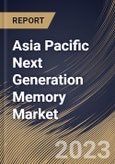The COVID-19 pandemic has brought both challenges and opportunities to the market. The disruptions in supply chains and uncertainties in the economic landscape have impacted the production and distribution of memory components. However, the pandemic has also highlighted the importance of memory solutions in supporting remote work, online education, and telehealth services. As society adapts to the new normal, the demand for high-speed and reliable memory solutions has increased, potentially accelerating the adoption of next-generation memory technologies.
One notable trend in the market is the collaboration between established memory manufacturers and startups. Established giants in the semiconductor industry are recognizing the potential of next-generation memory technologies and are partnering with innovative startups to bring these solutions to market. These partnerships enable the integration of next-generation memory into existing technology ecosystems, driving faster adoption.
Another significant trend is the development of storage-class memory (SCM). SCM bridges the gap between traditional volatile memory (e.g., DRAM) and non-volatile memory (e.g., NAND Flash). It combines the speed of DRAM with the persistence of NAND Flash, offering a versatile solution for applications requiring both speed and data retention. SCM, such as Intel's Optane, is gaining traction in data center applications, where rapid data access is paramount.
China's manufacturing prowess extends to a wide range of industries, including consumer electronics, automotive, and industrial equipment. The country's emphasis on becoming a global manufacturing hub has led to a surge in demand for high-performance memory solutions. In the consumer electronics sector, Chinese smartphone manufacturers are incorporating next-generation memory technologies to meet the expectations of faster and more responsive devices.
Additionally, China's rapid adoption of IoT devices, smart appliances, and wearable technology necessitates memory solutions that can handle data processing at the edge. This expanding manufacturing excellence within China's borders has not only boosted the domestic production of advanced memory solutions but has also created opportunities for global memory technology companies to invest in and collaborate with local manufacturers. As these countries continue to lead in the consumer electronics industry and advance their manufacturing capabilities, the demand for next-generation memory is expected to grow steadily.
The China market dominated the Asia Pacific Next Generation Memory Market, By Country in 2022, and would continue to be a dominant market till 2030; thereby, achieving a market value of $2,532.8 million by 2030. The Japan market is registering a CAGR of 16.8% during (2023 - 2030). Additionally, The India market would showcase a CAGR of 18.3% during (2023 - 2030).
Based on Technology, the market is segmented into Non-volatile (Magneto-resistive Random-access Memory (MRAM), Ferroelectric RAM (FRAM), SRAM, Resistive Random-access Memory (ReRAM), Nano RAM, and Others), and Volatile. Based on Wafer Size, the market is segmented into 300 mm, and 200 mm. Based on Vertical, the market is segmented into Enterprise Storage, Consumer Electronics, BFSI, Telecommunications, Information Technology, Government, Automotive & Transportation, and Others.Based on countries, the market is segmented into China, Japan, India, South Korea, Singapore, Malaysia, and Rest of Asia Pacific.
The market research report covers the analysis of key stake holders of the market. Key companies profiled in the report include Samsung Electronics Co. Ltd., Micron Technology, Inc., Fujitsu Limited, Toshiba Corporation, Honeywell International, Inc., Microchip Technology, Inc., Everspin Technologies, Inc., Infineon Technologies AG, Kingston Technology Company, Inc., and Intel Corporation.
Scope of the Study
Market Segments Covered in the Report:
By Technology- Non-volatile
- Magneto-resistive Random-access Memory (MRAM)
- Ferroelectric RAM (FRAM)
- SRAM
- Resistive Random-access Memory (ReRAM)
- Nano RAM
- Others
- Volatile
- 300 mm
- 200 mm
- Enterprise Storage
- Consumer Electronics
- BFSI
- Telecommunications
- Information Technology
- Government
- Automotive & Transportation
- Others
- China
- Japan
- India
- South Korea
- Singapore
- Malaysia
- Rest of Asia Pacific
Key Market Players
List of Companies Profiled in the Report:
- Samsung Electronics Co. Ltd.
- Micron Technology, Inc.
- Fujitsu Limited
- Toshiba Corporation
- Honeywell International, Inc.
- Microchip Technology, Inc.
- Everspin Technologies, Inc.
- Infineon Technologies AG
- Kingston Technology Company, Inc.
- Intel Corporation
Unique Offerings
- Exhaustive coverage
- The highest number of Market tables and figures
- Subscription-based model available
- Guaranteed best price
- Assured post sales research support with 10% customization free
Table of Contents
Companies Mentioned
- Samsung Electronics Co. Ltd.
- Micron Technology, Inc.
- Fujitsu Limited
- Toshiba Corporation
- Honeywell International, Inc.
- Microchip Technology, Inc.
- Everspin Technologies, Inc.
- Infineon Technologies AG
- Kingston Technology Company, Inc.
- Intel Corporation
Methodology

LOADING...








